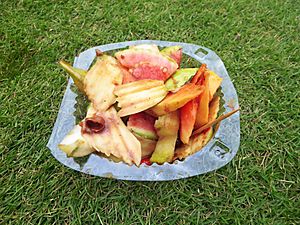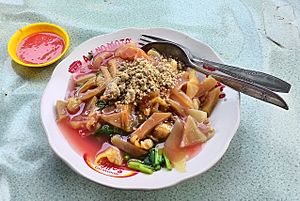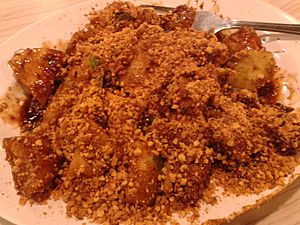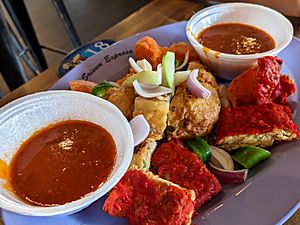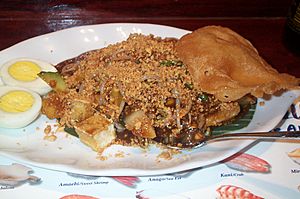Rojak facts for kids

Rujak.
|
|
| Alternative names | Lotis; Rujak |
|---|---|
| Type | Salad |
| Place of origin | Indonesia |
| Region or state | Java |
| Associated national cuisine | Indonesia, Malaysia, Singapore |
| Serving temperature | Fresh in room temperature |
| Main ingredients | Fruits, vegetables, palm sugar, peanuts and chilli dressing. |
Rujak (pronounced Roo-jahk) or Rojak (pronounced Roh-jahk) is a yummy salad from Java, an island in Indonesia. You can find this dish in Indonesia, Malaysia, and Singapore. The most popular kind is a mix of sliced fruits and vegetables. It comes with a spicy dressing made from palm sugar, ground chilli, and peanuts. People often call it a tangy and spicy fruit salad.
There are many different ways to make Rujak, especially in Indonesian cuisine. It is very popular all over Indonesia. The most common type uses fruits and vegetables. Its sweet and tangy sauce often includes prawn paste. Some Rujak recipes might even have seafood or meat. This is especially true in Malaysia and Singapore, where some versions are inspired by Indian Muslim food.
Contents
- What Does "Rujak" Mean?
- Rujak's Special Meaning
- Indonesian Rujak Dishes
- Fruit Rujak (Rujak Buah)
- Vinegar Rujak (Rujak Cuka)
- Mashed Rujak (Rujak Tumbuk)
- Shredded Rujak (Rujak Serut)
- Acehnese Rujak (Rujak u' Groeh)
- Wedding Rujak (Rujak Pengantin)
- Fish Broth Rujak (Rujak Kuah Pindang)
- Mouth Rujak (Rujak Cingur)
- Petis Rujak (Rujak Petis)
- Tolet Rujak (Rujak Tolet)
- Salted Cuttlefish Rujak (Rujak Juhi)
- Shanghai Rujak (Rujak Shanghai)
- Soto Rujak (Rujak Soto)
- Malaysian and Singaporean Rojak Dishes
- See also
What Does "Rujak" Mean?
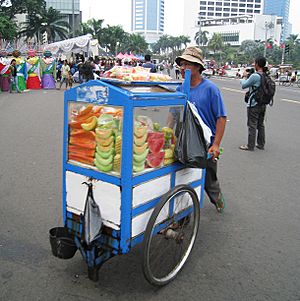
Rujak is one of the oldest known dishes from ancient Java. The word "rujak" comes from "rurujak". This word was found in an old Javanese writing from the year 901 CE. This was during the time of the Mataram Kingdom in Central Java.
Later, people from Java and Indian families living there shared this dish with other places. In Malaysia and Singapore, they spell it "rojak".
Rujak's Special Meaning
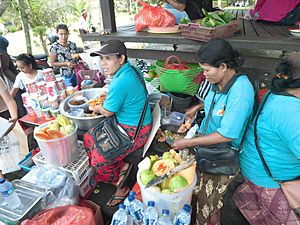
In Indonesia, especially among the Javanese, Rujak's sweet, spicy, and sour taste is very popular with pregnant women. This desire for unripe mangoes and other sour fruits is called "ngidham" in Javanese.
In Javanese culture, Rujak is a key part of a special ceremony. This ceremony is called Naloni Mitoni or tujuh bulanan (meaning "seventh month"). It is a traditional event for pregnant women. The Rujak is made to wish the mother-to-be a safe and easy delivery. A special fruit Rujak is made for this occasion. It is then served to the pregnant woman and her guests, usually her female friends.
The Rujak for this ceremony is like regular Indonesian fruit Rujak. But the fruits are roughly shredded, not thinly sliced. Also, jeruk bali (pomelo/pink grapefruit) is always an ingredient. People believe that if the Rujak tastes sweet, the baby will be a girl. If it tastes spicy, the baby will be a boy.
In the Batak Mandailing area of North Sumatra, Indonesia, making Rujak is a special event. It happens after the harvest. The whole village usually helps make and eat the Rujak.
In Malaysia and Singapore, "rojak" also means a mix of different things. It is often used to describe the many different groups of people in Malaysian and Singaporean society.
Indonesian Rujak Dishes
Fruit Rujak (Rujak Buah)
In Indonesia, Rujak buah is also known as rujak manis (sweet Rujak). This common Indonesian fruit Rujak has slices of different tropical fruits. These include jambu air (water apple), pineapple, unripe mangoes, bengkoang (jicama), cucumber, kedondong, and raw red ubi jalar (sweet potato). Sometimes, green apples from Malang, belimbing (starfruit), and jeruk Bali (pomelo) are added.
The sweet and spicy bumbu rujak dressing is made from water, gula jawa (palm sugar), asem jawa (tamarind), crushed peanuts, terasi (prawn paste), salt, bird's eye chilli, and red chilli. All the fruits are cut into small pieces. The thick, sweet, and spicy Rujak dressing is poured over them. Some people like to add sambal garam powder (salt and ground red chilli) for a saltier taste. Javanese people call this type of Rujak lotis.
Vinegar Rujak (Rujak Cuka)
Rujak cuka means "vinegar Rujak". It is a special dish from Sundanese cuisine in West Java. It is known for its fresh, sour taste. It is made with shredded fruits like pineapple and unripe mango. It also has vegetables such as jícama, cabbage, bean sprouts, and cucumber. It is similar to asinan because both dishes have a sour and spicy dressing. This dressing contains vinegar, palm sugar, and chilli.
Mashed Rujak (Rujak Tumbuk)
This is another type of Indonesian fruit Rujak from West Java. The ingredients are almost the same as typical fruit Rujak. However, all the ingredients are ground or mashed together. This is done in a wooden mortar. The fruits used are young pisang batu (a type of plantain), raw red yam, jicama, Java apple, kedondong, and young unripe mango. The dressing is not poured on top. Instead, it is mashed together with all the other ingredients. The dressing has terasi prawn paste, palm sugar, salt, and bird's-eye chilli.
Traditionally, Rujak tumbuk is served in small portions on banana leaf plates called pincuk. Today, it is also often served in plastic cups.
Shredded Rujak (Rujak Serut)
This Rujak means "shredded Rujak". It is another type of Indonesian fruit Rujak. The ingredients are similar to other fruit Rujak. But the fruits are not cut into pieces. Instead, they are shredded into a rough, grated texture.
Acehnese Rujak (Rujak u' Groeh)
This is a special dish from Aceh province. It has very young and soft coconut meat, young (green) papaya, bird's eye chilli, sugar, palm sugar, ice, salt, and a bit of lime. This Rujak tastes best when it is cold.
Wedding Rujak (Rujak Pengantin)
"Pengantin" means "bride and groom" in Indonesian. This Rujak reminds people of Indonesia's old colonial food. It has slices of boiled eggs, potatoes, fried tofu, pineapple, carrot, bean sprouts, pickles, chilli, lettuce, cabbage, and cucumber. It also includes emping crackers, roasted peanuts, peanut sauce, and a little vinegar. Some versions mix the peanut sauce with mayonnaise. It is a bit like Central Javanese gado-gado.
Fish Broth Rujak (Rujak Kuah Pindang)
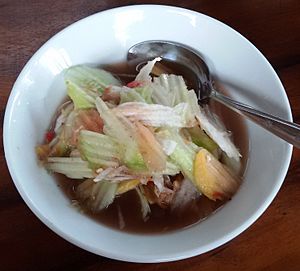
Rujak is a popular street food in Bali. This Balinese version of Indonesian fruit Rujak is different. Instead of the usual Rujak dressing, the fruits are soaked in a spiced fish broth. This broth is made from terasi (fermented prawn paste), salt, bird's eye chilli, red chilli, and pindang fish broth.
Mouth Rujak (Rujak Cingur)
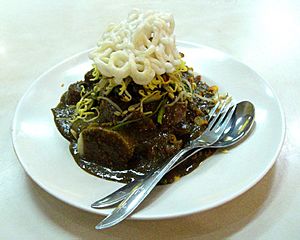
Cingur (pronounced "ching-ur") means "mouth" in Javanese. This Rujak comes from Surabaya. This special Rujak from East Java has a "meaty" taste. It contains slices of cooked buffalo or cow lips. It also has bangkuang, unripe mango, pineapple, cucumber, kangkung, lontong (rice cake), tofu, and tempe. All of these are served in a black sauce. This sauce is made from petis (black fermented prawn paste, like terasi) and crushed peanuts. It is topped with fried shallots and kerupuk (Indonesian prawn crackers).
Petis Rujak (Rujak Petis)
This is another type of Rujak from Surabaya. It has slices of bangkuang, unripe mango, cucumber, kangkung (water spinach), kedondong, tofu, and soybean sprouts. All these are served in a black sauce. This sauce is made from petis (sticky black fermented prawn paste, like terasi), fried shallots, salt, palm sugar, unripe banana, and crushed peanuts. Traditionally, it is served on a banana leaf. Today, it is more often served on plates.
Tolet Rujak (Rujak Tolet)
This Rujak is similar to fruit Rujak and also from Surabaya. Besides unripe fruits, it also includes fried tofu, fried garlic, and sometimes beef tendons. The sauce is petis-based. It is mixed with palm sugar, slices of raw bird's eye chilli, and sweet soy sauce.
Salted Cuttlefish Rujak (Rujak Juhi)

Juhi means salted cuttlefish in Indonesian. This Rujak has fried tau kwa tofu, fried boiled potatoes, fried shredded salted cuttlefish, cucumber, noodles, lettuce, cabbages, peanut sauce, vinegar, and fried garlic. This dish started with the Chinese community in Batavia (now Jakarta). Now it is a Betawi dish, similar to Asinan Betawi.
Shanghai Rujak (Rujak Shanghai)
This Rujak is named after "Bioscoop Shanghay," a cinema in Batavia Kota. It was created by Indonesia's Chinese community. You can find this Rujak in Indonesian Chinatowns, like Glodok in Jakarta. Rujak Shanghai includes seafood, like Rujak Juhi. Boiled sliced gurita (octopus) and edible jellyfish are served with kangkung. It comes with a thick red sweet and sour sauce mixed with pineapple juice and toasted crushed peanuts. Usually, chilli sauce and pickled bengkoang are served with it.
Soto Rujak (Rujak Soto)
This is a special dish from Banyuwangi, East Java. It is a unique mix of beef soto and Rujak cingur. It is a local specialty where vegetable Rujak (water spinach and bean sprouts) is served with lontong rice cake in petis sauce. Then, soto soup is poured over it. Usni Solihin created it in 1975.
Malaysian and Singaporean Rojak Dishes
Fruit Rojak (Rojak Buah)
In Malaysia and Singapore, fruit Rojak usually has cucumber, pineapple, jícama, bean sprouts, taupok (puffy, deep-fried tofu), and youtiao (cut-up Chinese-style fritters). Unripe mangoes and green apples are used less often. The dressing is made from water, belacan, sugar, chilli, and lime juice. What's in it can change depending on the seller. Some add prawn paste (hae ko in Hokkien), tamarind, or black bean paste. The ingredients are cut into bite-sized pieces. They are tossed in a bowl with the dressing. Then, they are topped with crushed peanuts and a bit of ground or sliced torch ginger bud (bunga kantan in Malay).
A popular type found in Penang, Malaysia, is Rojak Penang. This version adds jambu air, guava, squid fritters, and honey. It uses more tart fruits like unripe mangoes and green apples. Bean sprouts and fried tofu puffs are usually left out. The sauce for this Rojak is very thick, almost like toffee.
Indian Rojak (Rojak Mamak)
In Malaysia, mamak rojak (also called Indian rojak or Pasembur) is found at Mamak stalls. These are Muslim Malaysian Indian food stalls where rojak mamak is a popular dish. It has fried dough fritters, tofu, boiled potatoes, prawn fritters, hard-boiled eggs, bean sprouts, cuttlefish, and cucumber. All of these are mixed with a sweet, thick, spicy peanut sauce. In northwestern states of Peninsular Malaysia, like Penang and Kedah, it is always called pasembur. But in Kuala Lumpur, it is called rojak mamak.
In Singapore, Indian Rojak has a mix of potatoes, hard-boiled eggs, tofu, and prawn fritters. These are often brightly colored. Customers usually pick their favorite items from a display. Then, the items are heated in a wok, chopped up, and served. A sweet and spicy peanut and chilli sauce is given on the side for dipping.
Bandung Rojak (Rojak Bandung)
This is a Singaporean dish known as Rojak Bandung. It has cuttlefish, kangkung, cucumber, tofu, peanuts, chilli, and sauce. Rojak Bandung has no connection to the Indonesian city of Bandung. In the Malay language, the word bandung means "pairs".
See also
 In Spanish: Rujak para niños
In Spanish: Rujak para niños



